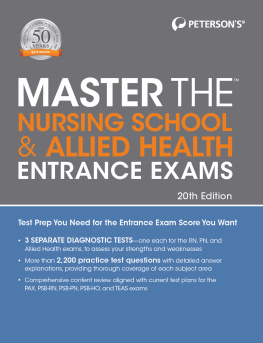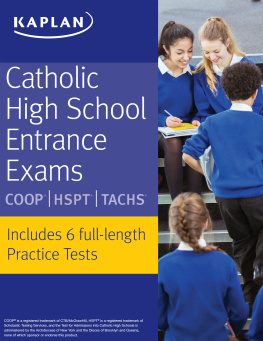Before You Begin
Why You Should Use This Book
If youre in the eighth grade and are preparing to continue your education at a Catholic high school, then this book is just what you need. An essential part of getting into the school of your choice is taking and passing an entrance exam.
This book has been specially designed to assist you with preparing for and taking the two most commonly used Catholic high school entrance exams, the COOP and the HSPT. It will also introduce you to the SSAT and the ISEE, two other widely used tests. If you live within the Archdiocese of New York, or the Diocese of Brooklyn and Rockland County, you probably will have to take the Test for Admissions into Catholic High Schools, commonly known as the TACHS. Exercises are included here to prepare you for that test also. Youll find help with answering questions in every test subject and plenty of practice to get you ready for your exam. Master the Catholic High School Entrance Exams will not only help you develop your test-taking skills, it also includes descriptions and examples of each type of entrance exam and eight full-length practice examstwo TACHS, two COOPs, two HSPTs, one SSAT, and one ISEE.
The TACHS, COOP, HSPT, SSAT, and ISEE practice exams simulate the type of questions you can expect to find on the actual exams. However, the test-makers may have instituted changes after this book was published. To see if new information regarding the tests is available, check Petersons Web site ( www.petersonspublishing.com/publishingupdates ). In addition, this book provides skills review and practice questions in each of the subject areas covered by typical entrance exams. Use these sections to help you strengthen your weak areas.
How This Book is Organized
Divided into sections, this book provides four main parts that can help you with your preparation.
Use Part I to learn more about each exam type and how its scored. Youll find examples of typical questions from each exam. Use Part II to review the verbal skill sections of the TACHS, COOP, and HSPT exams, such as analogies, verbal logic, reading, and composition. Use Part III to review quantitative and nonverbal skills, such as mathematics. Part IV includes practice exams for the TACHS, the COOP, the HSPT, the SSAT, and the ISEE.
How To Use This Book
Diagnostic Test Method One way to use this book is to start with a diagnostic test.
A diagnostic test is a test that helps you understand your strengths and weaknesses on the exam. It diagnoses the skills that need the most improvement. In this method, you take a diagnostic test first. Then you use the results of your diagnostic to develop a study plan. Use one of the practice tests in Part IV as your diagnostic test. Take this test under realistic testing conditions.
Go to a quiet setting, away from distractions. Time yourself as you would be timed on the real test, making sure to complete all test sections at once. Once youve taken your diagnostic test, score yourself to see your strengths and weaknesses. How did you do? Make a list of your strong and weak areas. If you scored well on Math but poorly on Verbal Skills, then you can count Math as a strength. Your Verbal Skills, on the other hand, will need some work.
Rank the different sections in terms of your strongest and weakest skills. Use your ranking list to develop your study plan. Your plan should prioritize boosting your weaker skills. You dont need to spend as much time brushing up on your strengths. However, you should plan to spend some time on strong skills exercisesjust to stay in shape! Once youve got a study plan, put it to work. Read the introduction to your test in Part I.
Then, focus on improving your weak skills by studying the sections in Parts II and III. After youve reviewed the content sections, take your second practice test. This test should show an improvement in your score! Front-to-Back Method Another way to use this book is the front-to-back method. In this method, you work through the book the way it is organized. This method might be quickest if you dont have the time to take two practice tests. Start at Part I of the book and carefully read through the introductory section on your exam.
This will help you understand the exam and how its scored. Next, study the content sections in Parts II and III. Focus on the sections that relate to your exam. If you know your strong and weak skills, you might devote extra time to sections where you need the most improvement. After youve reviewed the content, take a practice test or two in Part IV. Even taking one test will help you be more prepared for exam day.







 About Petersons Publishing To succeed on your lifelong educational journey, you will need accurate, dependable, and practical tools and resources. That is why Petersons is everywhere education happens. Because whenever and however you need education content delivered, you can rely on Petersons to provide the information, know-how, and guidance to help you reach your goals. Tools to match the right students with the right school. Its here. Its here. Its here.
About Petersons Publishing To succeed on your lifelong educational journey, you will need accurate, dependable, and practical tools and resources. That is why Petersons is everywhere education happens. Because whenever and however you need education content delivered, you can rely on Petersons to provide the information, know-how, and guidance to help you reach your goals. Tools to match the right students with the right school. Its here. Its here. Its here.